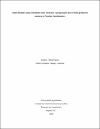Tejido dinámico como articulador entre estructura y programa de una vivienda productiva panelera en Nocaima Cundinamarca
Fecha de publicación
2021-08-25Idioma del documento
spaResumen
La Investigación esta inclinada hacia la relación entre estructura y programa de una enramada panelera y una vivienda rural a partir de la pregunta que vincula las dos variables, cómo contexto de desarrollo se opta por Nocaima Cundinamarca; inclinándose así por el factor de tradición y cultura de la enramada panelera dando respuesta a la problemática de desvinculación que hay entre la vivienda rural y el trapiche.
Urbanamente se plantea una red municipal con esta vivienda replicable y adaptable a todo tipo de topografía como se puede ver en la figura Figura 4. Nodos paneleros y su ubicación en el municipio de Nocaima.
Continuando con el proceso se hace un estudio de campo en el cual se reconocen los tipos de enramada y tipos de vivienda predominantes en Nocaima. Realizando a su vez un análisis con fichas de trabajo de producción panelera, visitando tres tipos de enramada y tres tipos de vivienda, creando fichas de notación que permiten entender el funcionamiento y proceso productivo, como se desarrolla espacialmente este tipo de producción y que tipo de estructura lo compone con sus programas productivos, especificando estructuralmente el modo de funcionamiento y el modo de tecnificación que tienen.
Paralelo a esto se realiza un diagrama del programa arquitectónico involucrando las dos variables, dándole un orden a partir de reglas que previamente permitirán realizar una ubicación en el campo de actuación. Partiendo del ejercicio de no composición.
Abstract
The research is inclined towards the relationship between structure and program of a panelera enramada and a rural house from the question that links the two variables, how development context is chosen by Nocaima Cundinamarca; thus leaning towards the factor of tradition and culture of the panelera enramada responding to the problem of disconnection between rural housing and the sugar mill.
Urbanly, a municipal network is proposed with this replicable and adaptable housing to all types of topography as can be seen in figure Figure 4. Panelero nodes and their location in the municipality of Nocaima.
Continuing with the process, a field study is carried out in which the types of enramada and predominant types of housing in Nocaima are recognized. In turn, carrying out an analysis with panela production worksheets, visiting three types of bower and three types of housing, creating notation cards that allow understanding the operation and production process, how this type of production is developed spatially and what type of structure composes it with its production programs, structurally specifying the mode of operation and the mode of technification they have.
Parallel to this, a diagram of the architectural program is made involving the two variables, giving it an order based on rules that will previously allow a location in the field of action. Starting from the exercise of non-composition
Palabras clave
Colecciones
 Esta obra está bajo licencia internacional Creative Commons Reconocimiento-NoComercial 4.0.
Esta obra está bajo licencia internacional Creative Commons Reconocimiento-NoComercial 4.0.

